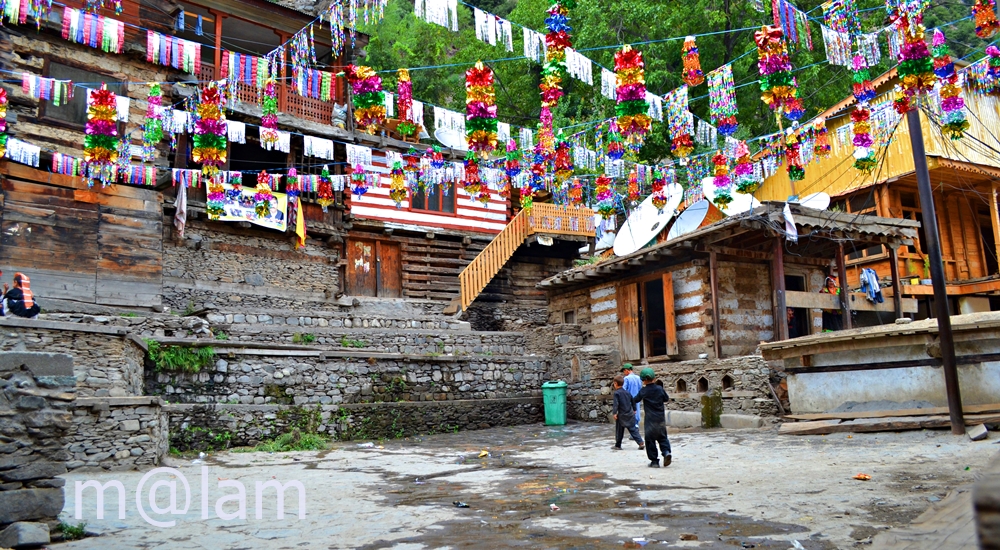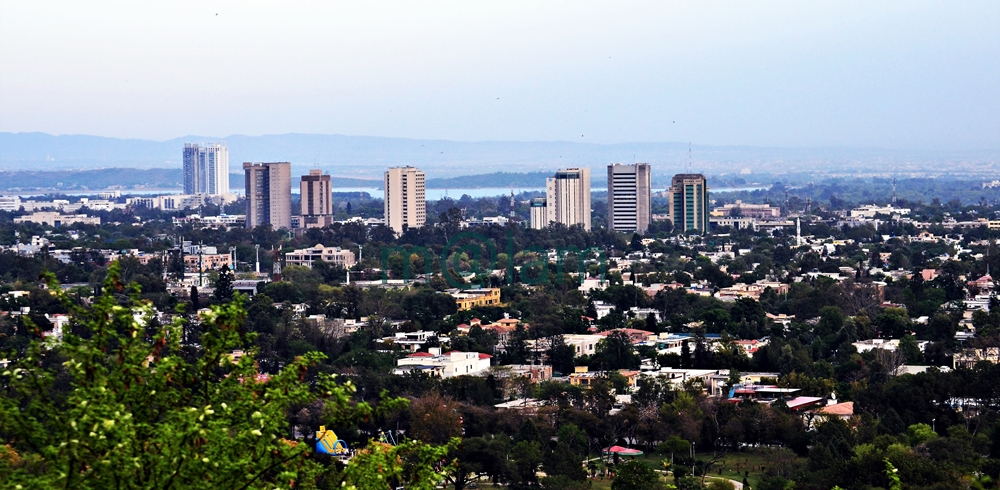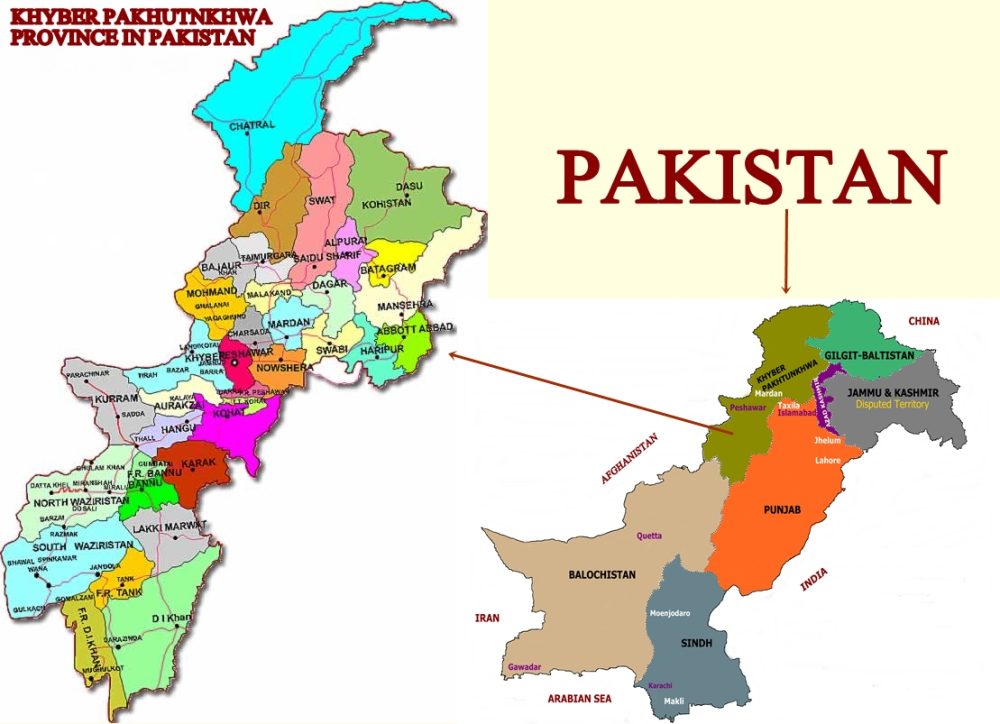The Enigmatic Beauty of the Kalash Valley
Nestled in the Hindu Kush mountain range within Chitral, The Kalash Valley is renowned for its distinct charm and cultural richness. Inhabiting this picturesque region are the Kalash people, a community with a unique culture, language, and a distinctive form of ancient Hinduism. In fact, one of the distinguishing features of the Kalash Valley is its cultural diversity. The Kalash people have undoubtedly preserved their ancient traditions and rituals, making their lifestyle a subject of fascination. Their festivals, folklore, and vibrant ceremonies contribute to the valley’s unique atmosphere.
The entire Kalash Valley comprises three primary valleys—Bumburet, Rumbur, and Birir. Each of these valleys is embraced by the untamed Kunar River. Positioned at an elevation surpassing 6,500 feet above sea level, the valley’s rugged terrain showcases steep slopes, narrow gorges, and rocky landscapes, creating a breathtaking backdrop. As such, the Kalasha Valleys are a source of attraction for Pakistani as well as International tourists.
The three Kalash valleys
Bumburet Valley
The Bumburet Valley is the largest, most picturesque, and most populous valley among the three Kalash Valleys. It is accessible via a road from Ayun in the Kunar Valley. This valley reaches an elevation of 1,640 meters (5,380 ft) where it meets the Rumbur Valley. Further downstream, it joins the Kunar Valley at the village of Ayun, situated at 1,400 meters (4,600 ft) and approximately 20 kilometers (12 mi) south of Chitral. To the west, Bumburet Valley ascends to a pass connecting to Afghanistan’s Nuristan Province at about 4,500 meters (14,800 ft). Despite its scenic beauty, the population in the region is facing a rapid decline. The most famous and frequently visited among the three valleys is Bumburate, located 36 kilometers from the main city of Chitral.
Rumbur Valley
The Rumbur Valley is a side valley situated to the north of Bumburet, approximately 32 kilometers from Chitral. It is the third and least populated of the Kalash Valleys.
Birir Valley
The Birir Valley, also known as Biriu, is a side valley of the Kunar Valley positioned south of Bumburet, located about 34 kilometers from Chitral. The Birir Valley is one of the oldest settlements of the Kalash tribe and has retained its authenticity in terms of architecture and local customs. The houses, streets, and pavements in Birir Valley are constructed from stones and wood, reflecting the traditional practices followed by the locals.
History
The Kalash valleys in Chitral boast a rich history. One of the major highlights is the presence of the Kafir-Kalash, also known as the “Wearers of the Black Robe.” This primitive pagan tribe adds a unique cultural dimension to the region. However, the origins of the Kalash people are shrouded in mystery and subject to controversy.
Numerous myths surround the ancestry of the Kalash people, with one prevailing legend suggesting a connection to Alexander the Great’s army. According to this tale, five soldiers from the legions of Alexander of Macedon settled in Chitral and are believed to be the forebears of the Kafir-Kalash. This myth weaves a historical link between the ancient Greek conqueror and the Kalash people.
Another intriguing narrative revolves around the migration of the Kalash ancestors to Chitral from the land of Tsiyam. The original homeland of the Kalash people, referred to in their folk songs, is believed to be Tsiyam. The details of this migration and the cultural elements retained by the Kalash people from their ancestral land contribute to the richness of their heritage.
Overall, the history of the Kalash valleys is intertwined with these captivating myths and legends. Subsequently, it creates an aura of mystery and fascination surrounding the origins of the Kafir-Kalash.
Religion
The Kalash people, who inhabit the remote Kalash Valley in Pakistan, follow a distinctive and ancient polytheistic religion known as the Kalash religion. Rooted in animism and nature worship, their belief system revolves around a pantheon of gods and goddesses. Central to the Kalash religious practices is the veneration of various deities, with Dezau being the supreme God and Maha Devi serving as his consort. These divine figures are believed to govern different facets of life, including fertility, harvests, and protection. The Kalash people hold nature in high regard, assigning spiritual significance to mountains, rivers, and trees.
Religious rituals and ceremonies are integral components of the Kalash cultural identity. The community’s festivals are marked by joyous celebrations, featuring music, dance, and feasting. These events serve as occasions for the Kalash people to express gratitude to their deities, seek blessings, and ensure the prosperity of their community.
Preserving their religious traditions is of utmost importance to the Kalash people. Particularly, as their way of life encounters challenges in the face of a changing world. Efforts are underway to safeguard their unique beliefs and cultural heritage, highlighting the significance of the Kalash religion as a captivating aspect of this vibrant and distinct community.
Culture
The culture of the Kalash people stands out as unique and distinct, differing significantly from the many contemporary Muslim ethnic groups in northwestern Pakistan that surround them. Nature assumes a highly significant and spiritual role in their daily lives, and as part of their religious tradition, they conduct sacrifices and hold festivals to express gratitude for the abundant resources of their three valleys.
The mythology and folklore of the Kalash people have been likened to that of ancient Greece, although a closer parallel can be drawn to Vedic mythology. This cultural richness, drawing from ancient traditions and beliefs, adds a layer of fascination for observers and anthropologists. The Kalash people’s unique cultural practices have captivated anthropologists, particularly in contrast to the predominant cultures in the surrounding region.
The celebration of nature, the religious rituals, and the preservation of ancient mythological narratives contribute to the distinctive cultural tapestry of the Kalash people. Their way of life serves as a testament to the diversity that exists within the broader cultural landscape of Pakistan’s northwestern regions.
People
The Kalash people constitute a small religious and ethnic minority in Pakistan, enjoying legal and constitutional protection as a scheduled tribe. They adhere to a polytheistic belief system and, historically, their population exceeded 200,000. Unfortunately, over the decades, their numbers have dwindled to a range of 3,000 to 4,000 individuals, primarily due to forced conversions and persecution. Some Kalash individuals have voluntarily embraced Islam, but upon conversion, they are typically excluded from the local Kalash community.
Despite being a minority, the Kalash people, as a rule, do not intermarry or cohabit with local Muslims. However, it’s noteworthy that they maintain a non-hostile stance towards them. The dynamics between the Kalash people and the local Muslim population are characterized by a degree of separation, with each community generally keeping to itself.
Surprisingly, an intriguing aspect of Kalash culture is their distinctive approach to death. Rather than mourning, they celebrate it as a joyous occasion, considering it a happy return of the soul to God. In a unique cultural practice, the best gift one can offer for the departed soul is a grand dance. The overall demeanor of the Kalash people is friendly, and their lifestyle and traditions make them a subject of interest for outsiders. However, visitors need to respect their privacy and seek permission before engaging in activities like photography or interviews.
Architecture
The traditional architecture of the Kalash people is characterized by wooden houses strategically constructed atop hills surrounding the valley. A distinctive feature of many traditional Kalash houses is their stacked arrangement, with structures built on top of one another, creating a unique and picturesque landscape.
Kalash architecture is a captivating blend of ancient woodcraft and medieval traditions of figure art. The buildings showcase magnificent examples of carved wooden pillars and beams, adorned with intricate depictions of human and animal figures and effigies. These carvings often represent specific myths and superstitions significant to the Kalash culture, providing a visual narrative of their rich folklore.
The carved elements on the pillars and beams not only contribute to the aesthetic appeal of the structures but also serve as a means of storytelling, preserving the cultural heritage of the Kalash people. The unique combination of woodcraft and figure art in Kalash architecture reflects the community’s commitment to maintaining their traditional practices and expressing their cultural identity through the artistry of their homes.
Dress
The traditional dress of the Kalasha people is a key aspect of their cultural identity. Kalasha women typically wear long black robes, often adorned with intricate embroidery and cowrie shells. This distinctive attire has earned them the local name of “the Black Kafirs” in Chitral. In contrast, Kalasha men have adopted the Pakistani shalwar kameez, a traditional outfit consisting of loose-fitting trousers paired with a long tunic.
Children in the Kalash community start wearing smaller versions of adult clothing from the age of four, reflecting an early incorporation of cultural attire. The clothing worn by Kalasha women is particularly noteworthy, representing one of the most significant elements of their cultural expression.
The materials used in Kalasha dresses include Shu, a fabric that, when combined with silk, forms the basis for their unique clothing. Beads and other items are often incorporated into intricate embroidery practices, adding to the richness of their attire. The Kalasha women’s topi, also known as Khalpol, is a distinct headgear with intricate designs. However, each person’s topi is unique with diverse colors and designs. Many Kalasha women take part in designing their headgear. It is made of woolen black material adorned with cowrie shells and buttons. Moreover, it is topped with a large colored feather. This picturesque head covering bears resemblance to similar headgear worn by women in parts of Greece today. The Kalasha people’s clothing, with its vibrant colors and detailed craftsmanship, serves as a visible expression of their cultural heritage and unique way of life.
Language
The Kalasha language, known as Kalasha-mun, belongs to the Indo-Aryan language family, and its closest relative is the neighboring Khowar language. Historically, Kalasha was spoken over a larger area in south Chitral, but its usage has diminished, particularly in favor of Khowar. Presently, the Kalasha language is primarily confined to the western side valleys, and it is on the verge of extinction, with only around 4,000 speakers remaining.
There is an ongoing language shift towards Khowar, another language spoken in the region, posing a significant challenge to the preservation of Kalasha. Efforts are being made to counteract this shift and revitalize the Kalasha language. Initiatives focused on language preservation and education aim to safeguard this unique linguistic heritage in the face of current linguistic changes. The endeavor is to ensure that future generations continue to embrace and speak the Kalasha language, contributing to the overall preservation of the Kalash cultural identity.
Food
Food plays a pivotal role in the Kalash community, serving as a unifying element in both times of mourning and celebration. The Kalash people boast a distinctive culinary tradition that blends indigenous flavors with influences from local Pakistani cuisine. Their diet predominantly features locally grown produce, such as apricots, grapes, mulberries, walnuts, and wheat, emphasizing the richness of the valley’s natural resources.
A notable aspect of Kalash cuisine is the incorporation of walnut-infused dishes, including various types of walnut bread and walnut tea, which are commonly enjoyed in Kalashi households.
One traditional dish is the walnut ‘Phulka,’ a type of roti (flatbread) made from barley flour and crushed walnuts. To prepare this dish, dough is initially made in the standard way for basic rotis. Once the dough is ready, crushed walnuts are added to the center, and the dough is closed around them. The mixture is then spread out in the round, traditional shape of a roti and cooked on a tawa over a wood fire.
Additionally, walnut tea is a common beverage in Kalash households. Crushed walnuts are added to hot boiling water, creating a walnut tea similar to the preparation of milk tea. A typical Kalash meal often includes walnut bread served with walnut tea, showcasing the significance of walnuts in their culinary practices. This unique combination reflects not only the availability of local resources but also the cultural richness embedded in the preparation and sharing of food within the Kalash community.
Music
Kalasha traditional music is characterized by a combination of flute-like instruments, singing, poetry, clapping, and rhythmic drum playing. The musical ensemble includes the following drums:
Wãc: This is a small hourglass-shaped drum made from materials such as ‘chizhin’ (pine wood), ‘kuherik’ (pine nut wood), or ‘az’a’i’ (apricot tree wood). The Wãc is played as part of the Kalasha dances and is often accompanied by a larger drum called Dãu.
Dãu: The Dãu is a large drum that complements the Wãc in Kalasha dances. It provides a deeper and more resonant sound compared to the smaller drum. The combination of Wãc and Dãu contributes to the rhythmic and dynamic elements of Kalasha traditional music.
These drums, along with other musical elements, form an integral part of the Kalasha cultural expression. The music accompanies various ceremonies, celebrations, and traditional dances, adding a vibrant auditory dimension to the community’s rich cultural heritage. The use of indigenous materials for crafting the instruments further reflects the connection between Kalasha music and the natural resources of their valley.
Festivals
Uchal:
Uchal is a renowned religious festival celebrated annually by the Kalasha people from August 20 to 22. This festival marks the harvest and threshing of wheat crops in the valleys of Bumburate, Birir, and Rumbur. Described as a “Thanksgiving movement,” Uchal provides the Kalasha community with an opportunity to express gratitude to nature and their Creator for the bountiful harvest. Preceding the harvest, the Kalasha people indulge in festivities with cheese, corn, and wine. Music and dance, accompanied by the beat of drums, are integral to the celebration. Women, particularly adorned in traditional dresses, form circles and dance to various songs. The festivities also include special foods such as cheese, buttermilk, and cornbread.
Chawmos:
Chawmos, the most significant festival of the Kalash people, is celebrated during the winter solstice, from December 7 to 22. Dedicated to their God, Balimain, who is believed to have visited Kalash from the mythical homeland Tsyam during the festival. Chawmos marks the end of the year and is a thanksgiving celebration for the year’s harvest. Rituals during the festival include purifying individuals by waving a band of fire above their heads by a shaman. Pure men sing old songs, and some men dress up as women in a ritual symbolizing the dual nature of their God, Balimain, who is seen as both a man and a woman. Fertility songs are sung during this ritual.
Chillam Joshi:
Chillam Joshi is celebrated in the middle of May, marking the arrival of spring. Festivities include gatherings, dancing to local drum beats, house decorations, and accessorizing of clothes. During Chillam Joshi, the Kalash people serve milk saved for 10 days before the festival. The festival serves as an occasion to thank their Gods and involves the purification of one-year-old babies. The vibrant celebrations capture the essence of spring and renewal in the Kalash culture.
Tourist Attractions
Kalash Valley in Pakistan is a captivating tourist destination renowned for its natural beauty and cultural richness. Here are some key attractions that draw visitors to the region:
Exploring the Three Kalash Valleys:
Immerse yourself in the distinctive lifestyle, architecture, and cuisine of the Kalash people in the three main valleys: Bamburet, Birir, and Rumbur.
Kalash Festivals:
Witness the vibrant Kalash festivals, including Chilim Joshi, Uchal, and Chawmos. Undoubtedly the local traditions, dances, and rituals come to life during these events.
Kalash Dur Museum & Cultural Center (Bamburet Valley):
Visit the Kalash Dur Museum to delve into the rich cultural heritage of the Kalash people. The center showcases artifacts, and traditional costumes, and provides insights into the community’s history.
Kalash Graveyard (Bamburet Valley):
Explore the Kalash graveyard, a site that reflects the cultural and religious practices of the Kalash people.
Mulberry Orchard (Birir Valley):
Experience the beauty of a Mulberry orchard in Birir Valley, known for its lush landscapes and agricultural practices.
Kalash Valley Circuit Trek:
For adventure enthusiasts, embark on the Kalash Valley Circuit Trek, which offers breathtaking views of the surrounding mountains and valleys.
Fruit Orchards:
Discover the fruit orchards in the region, where you can taste locally grown fruits, such as apples, apricots, and cherries.
Photographic Spots:
Capture the mesmerizing landscapes and the unique cultural elements of the Kalash Valley at various photographic spots throughout the region.
Visiting these attractions allows tourists to appreciate both the natural wonders and the cultural heritage that make Kalash Valley a remarkable destination.
Flora and Fauna
Aside from its cultural significance, the Kalash Valley is also a haven for biodiversity. The region boasts a rich variety of flora and fauna, with elusive creatures such as the snow leopard and the Himalayan black bear finding a home amidst its stunning landscapes. This ecological diversity adds an extra layer of allure to the already captivating Kalash Valley.
Know before you go
Before visiting Kalash Valley, it’s essential to be aware of and respect the local culture and traditions to ensure a positive and harmonious experience. Following are some guidelines for respectful interaction with the local community:
Dress Modestly:
- Dress modestly and appropriately, avoiding revealing or tight clothing.
- For both men and women, it’s recommended to cover shoulders, knees, and head, especially when visiting mosques or villages.
- Bright and colorful clothing is appreciated, as it is considered auspicious by the locals.
Greet Politely:
- Use the local greeting, “As-salaam alaykum,” which means “peace be upon you.”
- Employ local terms of respect such as “bhai” or “behen” for brother or sister, and “uncle” or “aunty” for elders.
- Smile, make eye contact, and show warmth to convey friendliness and appreciation.
Ask for Permission:
- Seek permission before taking photos or videos of locals, their homes, or animals to respect their privacy.
- Request permission before entering houses or mosques to honor local customs and traditions.
- Always ask for permission before touching or picking anything from gardens or fields to respect property and livelihood.
Tip Generously:
- Show gratitude by tipping generously for services provided by drivers, guides, porters, cooks, and hosts.
- Consider tipping locals who share their stories, culture, and hospitality.
- Base tips on the quality and duration of service, and be mindful of your budget and satisfaction.
Accommodation:
When seeking accommodation in Kalash Valley, consider opting for a place that provides not only a comfortable stay but also breathtaking views of the surrounding landscapes. Here’s what you can expect from accommodations with a view of the area:
Spectacular Views:
Enjoy stunning vistas of the Kalash Valley and the majestic mountains from your accommodation. Wake up to the beauty of nature right outside your window.
Luxurious Amenities:
Experience luxury with comfortable beds, well-maintained rooms, and private bathrooms. Accommodations with a view aim to provide a relaxing and indulgent environment for guests.
Delicious Gourmet Food:
Indulge in gourmet food prepared with local ingredients and recipes. These accommodations often showcase the culinary delights of the region, allowing guests to savor the flavors of Kalash Valley.
Clean and Well-Maintained Rooms:
Expect cleanliness and attention to detail in your accommodation. The rooms are designed to offer a cozy and inviting space for travelers.
Serene Atmosphere:
Immerse yourself in a serene atmosphere. Accommodations with a view provide an ideal setting for guests to unwind, relax, and appreciate the natural beauty and harmony of the surroundings. Choosing accommodation with a view not only enhances the overall experience of your stay but also allows you to connect with the captivating landscapes that make Kalash Valley a sought-after destination.
Best Time to Visit
Kalash Chitral boasts a moderate climate with distinct seasonal variations. Here’s a breakdown of the weather conditions in Kalash Valley throughout the year:
Summer (June to August):
Average temperatures range from 20°C to 30°C (68°F to 86°F). Pleasant weather is ideal for exploring landscapes, engaging in outdoor activities, and participating in the vibrant cultural festivals of the Kalasha people.
Autumn (September to November):
Temperatures range from 10°C to 25°C (50°F to 77°F). Witness a change in foliage colors, with red, orange, and yellow hues creating a stunning backdrop for nature enthusiasts and photographers.
Winter (December to February):
Chilly temperatures with the possibility of dipping below freezing, ranging from -5°C to 10°C (23°F to 50°F). Expect snowfall, transforming the valley into a winter wonderland. Ideal for snow lovers and those seeking a cozy retreat amidst snow-covered mountains.
Spring (March to May):
Gradual transition from the cold winter to milder temperatures ranging from 10°C to 25°C (50°F to 77°F). The valley comes alive with blooming flowers, lush greenery, and cascading waterfalls, providing a revitalizing experience for nature enthusiasts. It’s essential to note that weather conditions can vary, and it’s advisable to check the local forecast before planning your trip to Kalash Valley. Being aware of the seasonal characteristics will help you plan your activities and pack accordingly for an enjoyable and comfortable stay in this picturesque region.
Access
Accessing the Kalash Valley involves navigating a challenging and adventurous route. Here are some details about reaching the valley:
Road Conditions:
The road to the valley is steep, narrow, and unpaved, adding an element of ruggedness to the journey.
Due to the region’s topography, the road is prone to landslides and rockfalls, especially during the rainy season.
Terrain Challenges:
Be prepared for a bumpy and thrilling ride, as the terrain can be demanding. The journey offers scenic views along the way, allowing travelers to enjoy the natural beauty of the surroundings.
Transport:
Access to the three Kalash Valleys is best achieved by 4WD (four-wheel drive) vehicles or Jeeps.
The use of these vehicles is recommended to navigate challenging road conditions and ensure a safe and reliable journey.
Starting Point:
The journey typically begins in Chitral Town. However, the drive to the Kalash Valleys involves navigating through the picturesque but challenging landscape.
Consideration for Seasons:
Given the road’s susceptibility to landslides and rockfalls, extra caution is required, especially during the rainy season. It’s advisable to check weather conditions and road status before embarking on the journey. Travelers should be prepared for an exciting yet challenging road trip, making the most of the stunning views along the way. Choosing the right type of vehicle and staying informed about the road conditions are essential aspects of ensuring a safe and enjoyable travel experience to the Kalash Valley.
Also Read:










